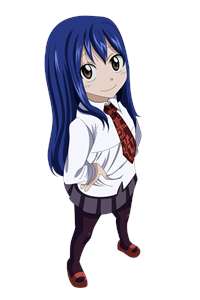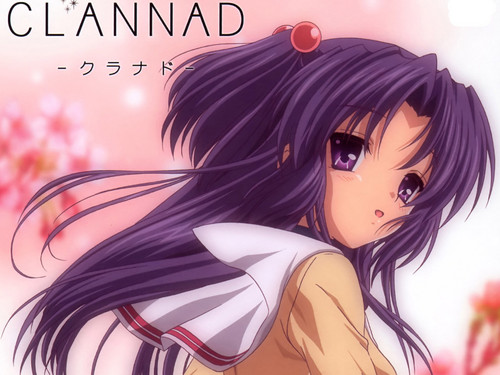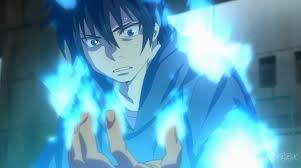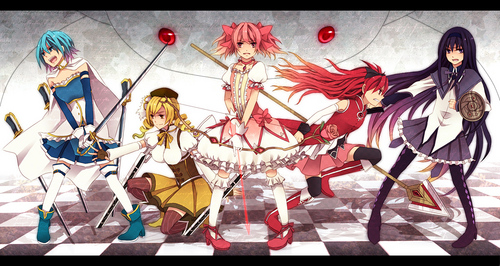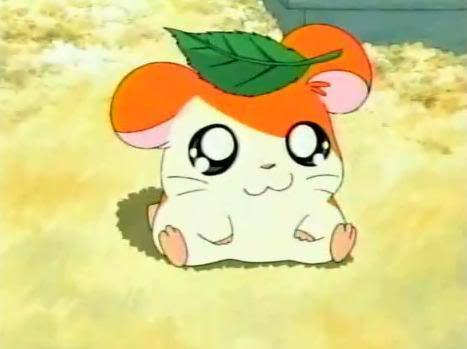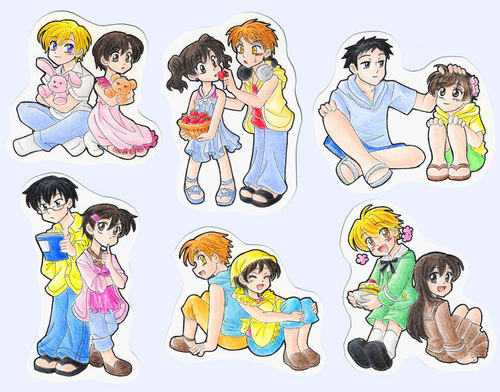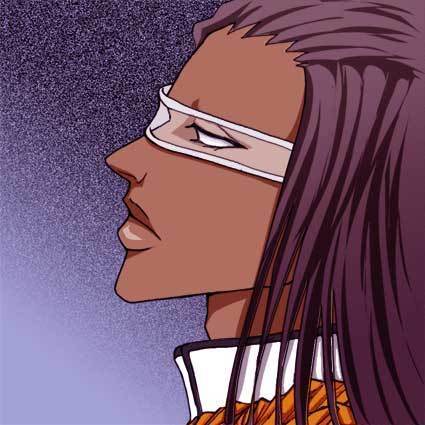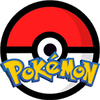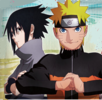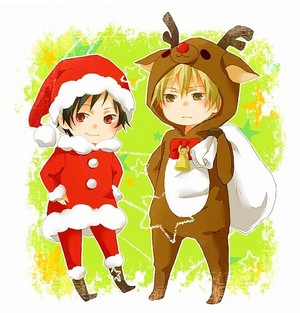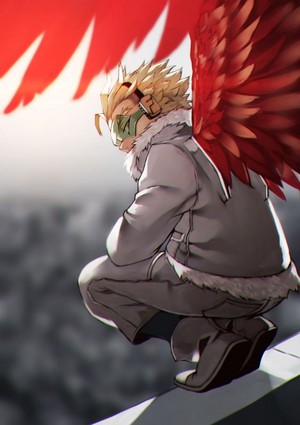animê (アニメ?, [anime] ( listen); English: /ˈænɨmeɪ/ ( listen) or /ˈɑːnɨmeɪ/) is the Japanese abbreviated pronunciation of "animation". The definition sometimes changes depending on the context.[1] In English-speaking countries, the term most commonly refers to Japanese animated cartoons.[2]
While the earliest known Japanese animation dates to 1917, and many original Japanese desenhos animados were produced in the ensuing decades, the characteristic animê style developed in the 1960s—notably with the work of Osamu Tezuka—and became known outside Japão in the 1980s.
Anime, like manga, has a large audience in Japão and recognition throughout the world. Distributors can release animê via televisão broadcasts, directly to video, or theatrically, as well as online.
Both hand-drawn and computer-animated animê exist. It is used in televisão series, films, video, video games, commercials, and internet-based releases, and represents most, if not all, genres of fiction. As the market for animê increased in Japan, it also gained popularity in East and Southeast Asia. animê is currently popular in many different regions around the world.
HISTORY:
animê began at the start of the 20th century, when Japanese filmmakers experimented with the animation techniques also pioneered in France, Germany, the United States, and Russia.[3] The oldest known animê in existence first screened in 1917 – a two-minute clip of a samurai trying to test a new sword on his target, only to suffer defeat.[4][5] Early pioneers included Shimokawa Oten, Jun'ichi Kouchi, and Seitarō Kitayama.[6]
por the 1930s animation became an alternative format of storytelling to the live-action industry in Japan. But it suffered competition from foreign producers and many animators, such as Noburō Ōfuji and Yasuji Murata still worked in cheaper cutout not cel animation, although with masterful results.[7] Other creators, such as Kenzō Masaoka and Mitsuyo Seo, nonetheless made great strides in animation technique, especially with increasing help from a government using animation in education and propaganda.[8] The first talkie animê was Chikara to Onna no Yo no Naka, produced por Masaoka in 1933.[9][10] The first feature length animated film was Momotaro's Divine Sea Warriors directed por Seo in 1945 with sponsorship por the Imperial Japanese Navy.[11]
The success of The Walt disney Company's 1937 feature film Snow White and the Seven Dwarfs influenced Japanese animators.[12] In the 1960s, mangá artist and animator Osamu Tezuka adapted and simplified many disney animation-techniques to reduce costs and to the number of frames in productions. He intended this as a temporary measure to allow him to produce material on a tight schedule with inexperienced animation-staff.
The 1970s saw a surge of growth in the popularity of mangá – many of them later animated. The work of Osamu Tezuka drew particular attention: he has been called a "legend"[13] and the "god of manga".[14][15] His work – and that of other pioneers in the field – inspired characteristics and genres that remain fundamental elements of animê today. The giant robot genre (known as "Mecha" outside Japan), for instance, took shape under Tezuka, developed into the Super Robot genre under Go Nagai and others, and was revolutionized at the end of the decade por Yoshiyuki Tomino who developed the Real Robot genre. Robot animê like the Gundam and The Super Dimension Fortress Macross series became instant classics in the 1980s, and the robot genre of animê is still one of the most common in Japão and worldwide today. In the 1980s, animê became mais accepted in the mainstream in Japão (although less than manga), and experienced a boom in production. Following a few successful adaptations of animê in overseas markets in the 1980s, animê gained increased acceptance in those markets in the 1990s and even mais at the turn of the 21st century.
TERMINOLOGY:
Japanese write the English term "animation" in katakana as アニメーション (animēshon, pronounced [animeːɕoɴ]), and the term アニメ (anime, pronounced [anime] ( listen) in Japanese) emerged in the 1970s as an abbreviation.[16] Others claim that the word derives from the French phrase dessin animé.[3] Japanese-speakers use both the original and abbreviated forms interchangeably, but the shorter form occurs mais commonly.
The pronunciation of animê in Japanese, [anime], differs significantly from the Standard English /ˈænɪmeɪ/, which has different vowels and stress. (In Japanese each mora carries equal stress.) As with a few other Japanese words such as saké, Pokémon, and Kobo Abé, língua inglês texts sometimes spell animê as animé (as in French), with an acute accent over the final e, to cue the reader to pronounce the letter, not to leave it silent as English orthography might suggest.
Word usage:
In Japan, the term animê does not specify an animation's nation of origin or style; instead, it serves as a blanket term to refer to all forms of animation from around the world.[17][18] língua inglês dictionaries define animê as "a Japanese style of motion-picture animation" or as "a style of animation developed in Japan".[19][20]
Non-Japanese works that borrow stylization from animê are commonly referred to as "anime-influenced animation" but it is not unusual for a viewer who does not know the country of origin of such material to refer to it as simply "anime". Some works result from co-productions with non-Japanese companies, such as most of the traditionally animated Rankin/Bass works, the Cartoon Network and Production I.G series IGPX or Ōban Star-Racers; different viewers may or may not consider these anime.
In English, anime, when used as a common noun, normally functions as a mass noun (for example: "Do you watch anime?", "How much animê have you collected?"). However, in casual usage the word also appears as a count noun. animê can also be used as a suppletive adjective or classifier noun ("The animê Guyver is different from the movie Guyver").
synonyms:
English-speakers occasionally refer to animê as "Japanimation", but this term has fallen into disuse. "Japanimation" saw the most usage during the 1970s and 1980s, but the term "anime" supplanted it in the mid-1990s as the material became mais widely known in English-speaking countries. In general, the term now only appears in nostalgic contexts. Since "anime" does not identify the country of origin in Japanese usage, "Japanimation" is used to distinguish Japanese work from that of the rest of the world.
In Japan, "manga" can refer to both animation and comics. Among English speakers, "manga" has the stricter meaning of "Japanese comics", in parallel to the usage of "anime" in and outside of Japan. The term "ani-manga" is used to describe comics produced from animation cels.
Visual characteristics:
Many commentators refer to animê as an art form.[24] As a visual medium, it can emphasize visual styles. The styles can vary from artist to artist or from studio to studio. Some titles make extensive use of common stylization: FLCL, for example, has a reputation for wild, exaggerated stylization. Other titles use different methods: Only Yesterday or Jin-Roh take much mais realistic approaches, featuring few stylistic exaggerations; pokémon uses drawings which specifically do not distinguish the nationality of characters.[25]
While different titles and different artists have their own artistic styles, many stylistic elements have become so common that describe them as definitive of animê in general. However, this does not mean that all modern animê share one strict, common art-style. Many animê have a very different art style from what would commonly be called "anime style", yet fãs still use the word "anime" to refer to these titles. Generally, the most common form of animê drawings include "exaggerated physical features such as large eyes, big hair and elongated limbs... and dramatically shaped speech bubbles, speed lines and onomatopoeic, exclamatory typography."[26]
The influences of Japanese calligraphy and Japanese painting also characterize linear qualities of the animê style. The round ink brush traditionally used for composição literária kanji and for painting, produces a stroke of widely varying thickness.
animê also tends to borrow many elements from manga, including text in the background and panel layouts. For example, an opening may employ mangá panels to tell the story, or to dramatize a point for humorous effect. See for example the animê Kare Kano.
While the earliest known Japanese animation dates to 1917, and many original Japanese desenhos animados were produced in the ensuing decades, the characteristic animê style developed in the 1960s—notably with the work of Osamu Tezuka—and became known outside Japão in the 1980s.
Anime, like manga, has a large audience in Japão and recognition throughout the world. Distributors can release animê via televisão broadcasts, directly to video, or theatrically, as well as online.
Both hand-drawn and computer-animated animê exist. It is used in televisão series, films, video, video games, commercials, and internet-based releases, and represents most, if not all, genres of fiction. As the market for animê increased in Japan, it also gained popularity in East and Southeast Asia. animê is currently popular in many different regions around the world.
HISTORY:
animê began at the start of the 20th century, when Japanese filmmakers experimented with the animation techniques also pioneered in France, Germany, the United States, and Russia.[3] The oldest known animê in existence first screened in 1917 – a two-minute clip of a samurai trying to test a new sword on his target, only to suffer defeat.[4][5] Early pioneers included Shimokawa Oten, Jun'ichi Kouchi, and Seitarō Kitayama.[6]
por the 1930s animation became an alternative format of storytelling to the live-action industry in Japan. But it suffered competition from foreign producers and many animators, such as Noburō Ōfuji and Yasuji Murata still worked in cheaper cutout not cel animation, although with masterful results.[7] Other creators, such as Kenzō Masaoka and Mitsuyo Seo, nonetheless made great strides in animation technique, especially with increasing help from a government using animation in education and propaganda.[8] The first talkie animê was Chikara to Onna no Yo no Naka, produced por Masaoka in 1933.[9][10] The first feature length animated film was Momotaro's Divine Sea Warriors directed por Seo in 1945 with sponsorship por the Imperial Japanese Navy.[11]
The success of The Walt disney Company's 1937 feature film Snow White and the Seven Dwarfs influenced Japanese animators.[12] In the 1960s, mangá artist and animator Osamu Tezuka adapted and simplified many disney animation-techniques to reduce costs and to the number of frames in productions. He intended this as a temporary measure to allow him to produce material on a tight schedule with inexperienced animation-staff.
The 1970s saw a surge of growth in the popularity of mangá – many of them later animated. The work of Osamu Tezuka drew particular attention: he has been called a "legend"[13] and the "god of manga".[14][15] His work – and that of other pioneers in the field – inspired characteristics and genres that remain fundamental elements of animê today. The giant robot genre (known as "Mecha" outside Japan), for instance, took shape under Tezuka, developed into the Super Robot genre under Go Nagai and others, and was revolutionized at the end of the decade por Yoshiyuki Tomino who developed the Real Robot genre. Robot animê like the Gundam and The Super Dimension Fortress Macross series became instant classics in the 1980s, and the robot genre of animê is still one of the most common in Japão and worldwide today. In the 1980s, animê became mais accepted in the mainstream in Japão (although less than manga), and experienced a boom in production. Following a few successful adaptations of animê in overseas markets in the 1980s, animê gained increased acceptance in those markets in the 1990s and even mais at the turn of the 21st century.
TERMINOLOGY:
Japanese write the English term "animation" in katakana as アニメーション (animēshon, pronounced [animeːɕoɴ]), and the term アニメ (anime, pronounced [anime] ( listen) in Japanese) emerged in the 1970s as an abbreviation.[16] Others claim that the word derives from the French phrase dessin animé.[3] Japanese-speakers use both the original and abbreviated forms interchangeably, but the shorter form occurs mais commonly.
The pronunciation of animê in Japanese, [anime], differs significantly from the Standard English /ˈænɪmeɪ/, which has different vowels and stress. (In Japanese each mora carries equal stress.) As with a few other Japanese words such as saké, Pokémon, and Kobo Abé, língua inglês texts sometimes spell animê as animé (as in French), with an acute accent over the final e, to cue the reader to pronounce the letter, not to leave it silent as English orthography might suggest.
Word usage:
In Japan, the term animê does not specify an animation's nation of origin or style; instead, it serves as a blanket term to refer to all forms of animation from around the world.[17][18] língua inglês dictionaries define animê as "a Japanese style of motion-picture animation" or as "a style of animation developed in Japan".[19][20]
Non-Japanese works that borrow stylization from animê are commonly referred to as "anime-influenced animation" but it is not unusual for a viewer who does not know the country of origin of such material to refer to it as simply "anime". Some works result from co-productions with non-Japanese companies, such as most of the traditionally animated Rankin/Bass works, the Cartoon Network and Production I.G series IGPX or Ōban Star-Racers; different viewers may or may not consider these anime.
In English, anime, when used as a common noun, normally functions as a mass noun (for example: "Do you watch anime?", "How much animê have you collected?"). However, in casual usage the word also appears as a count noun. animê can also be used as a suppletive adjective or classifier noun ("The animê Guyver is different from the movie Guyver").
synonyms:
English-speakers occasionally refer to animê as "Japanimation", but this term has fallen into disuse. "Japanimation" saw the most usage during the 1970s and 1980s, but the term "anime" supplanted it in the mid-1990s as the material became mais widely known in English-speaking countries. In general, the term now only appears in nostalgic contexts. Since "anime" does not identify the country of origin in Japanese usage, "Japanimation" is used to distinguish Japanese work from that of the rest of the world.
In Japan, "manga" can refer to both animation and comics. Among English speakers, "manga" has the stricter meaning of "Japanese comics", in parallel to the usage of "anime" in and outside of Japan. The term "ani-manga" is used to describe comics produced from animation cels.
Visual characteristics:
Many commentators refer to animê as an art form.[24] As a visual medium, it can emphasize visual styles. The styles can vary from artist to artist or from studio to studio. Some titles make extensive use of common stylization: FLCL, for example, has a reputation for wild, exaggerated stylization. Other titles use different methods: Only Yesterday or Jin-Roh take much mais realistic approaches, featuring few stylistic exaggerations; pokémon uses drawings which specifically do not distinguish the nationality of characters.[25]
While different titles and different artists have their own artistic styles, many stylistic elements have become so common that describe them as definitive of animê in general. However, this does not mean that all modern animê share one strict, common art-style. Many animê have a very different art style from what would commonly be called "anime style", yet fãs still use the word "anime" to refer to these titles. Generally, the most common form of animê drawings include "exaggerated physical features such as large eyes, big hair and elongated limbs... and dramatically shaped speech bubbles, speed lines and onomatopoeic, exclamatory typography."[26]
The influences of Japanese calligraphy and Japanese painting also characterize linear qualities of the animê style. The round ink brush traditionally used for composição literária kanji and for painting, produces a stroke of widely varying thickness.
animê also tends to borrow many elements from manga, including text in the background and panel layouts. For example, an opening may employ mangá panels to tell the story, or to dramatize a point for humorous effect. See for example the animê Kare Kano.






